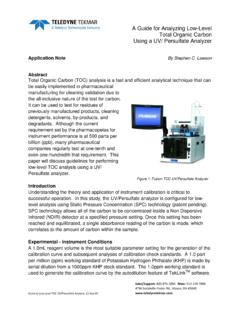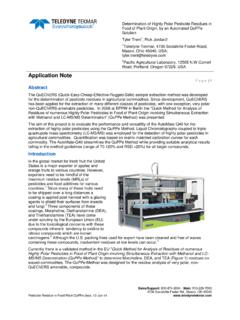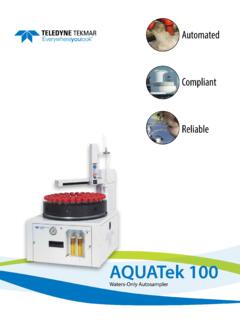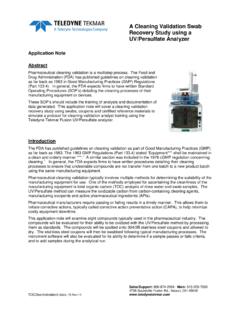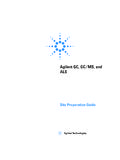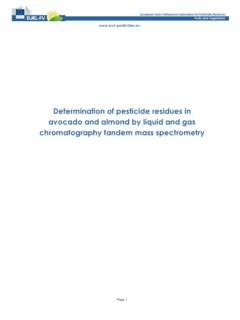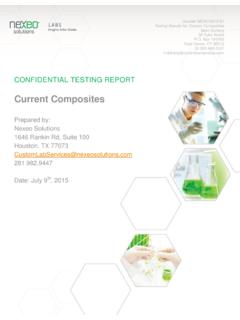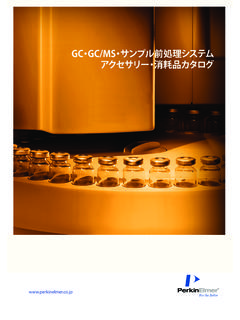Transcription of Analytical Trap Comparison for USEPA Method 8260C
1 Analytical Trap Comparison for USEPA Method 8260C Application Note Analytical Trap Comparison for USEPA Method 8260C ; 2/27/2012 Sales/Support: 800-874-2004 Main: 513-229-7000 4736 Socialville Foster Rd., Mason, OH 45040 Abstract Purge and trap concentration is a technique that is used for the analysis of Volatile Organic Compounds (VOCs). The major component of any purge and trap system is the Analytical trap. This trap is responsible for retaining the VOCs during the purge cycle and then releasing them upon heating and transfer to the GC/MS for separation and detection. While most standard methods define the dimensions of the trap as well as the recommended packing materials, there are multiple packing choices that can be substituted as long as they meet the Analytical requirements of the Method . For this study, four Analytical traps commonly used for purge and trap analysis will be compared using an automated VOC sample prep system.
2 Linear calibrations and Method Detection Limits (MDLs) will be established for US EPA Method 8260C1 compounds for each trap. Introduction A common technique used in the analysis of drinking/waste water is Purge and Trap Concentration (PTC). PTC is used for determining the VOCs that are present in drinking/waste water. The major component of any PTC system is the Analytical trap. This allows the analytes to be trapped and concentrated before being desorbed and sent to the GC/MS for separation and detection. Analytical traps are generally packed with multiple beds of adsorbent materials, to allow for differentiation of a broad range of compounds. The weaker adsorbent bed is placed on the top side of the trap, while the stronger adsorbent bed is placed below the weaker adsorbent bed. The less volatile analytes are not effectively desorbed by the stronger adsorbent material; they are retained in the weaker adsorbent bed.
3 In turn the less volatile analytes fail to reach the stronger adsorbent bed, so only the most volatile analytes reach the stronger adsorbent bed due to the volatility. Desorption is carried out by back-flushing the Analytical trap using the Gas Chromatograph (GC) carrier gas flow (Helium). Key features for an Analytical trap are as follows2: 1. At low temperatures, it must retain the desired analytes while allowing oxygen and water to pass through unimpeded. 2. Must release the analytes quickly and efficiently upon heating. 3. Must not contribute any volatiles of interest to the analysis. 4. Should have a reasonable price and lifetime. Most standard methods , such as USEPA Method 8260C1, define the dimensions of the Analytical trap as well as the recommended packing materials. Multiple packing material choices can be substituted as long as they meet the Method requirements.
4 In this study, four Analytical traps commonly used in P&T analysis (Tekmar #9, 3 Analytical trap, Vocarb 3000 and Vocarb 4000) will be compared using USEPA Method 8260C . Table 1 outlines the selected traps and their characteristics. Analytical Trap Comparison for USEPA Method 8260C Sales/Support: 800-874-2004 Main: 513-229-7000 4736 Socialville Foster Rd., Mason, OH 45040 Table 1: Characteristics and operating parameters for selected Analytical For this study, Teledyne Tekmar s Atomx, an automated VOC sample prep system, was used in conjunction with an agilent 7890/5975 GC/MS to evaluate each trap presented in Table 1 for USEPA Method 8260C . Different compound classes (gases, polar compounds, halogens, aromatics, and high boiling point/ late eluting compounds) will be evaluated for each trap. Experimental-Instrument Conditions The Atomx, equipped with each trap, and an agilent 7890A GC with a 5975C inert XL MSD were utilized for this study.
5 Tables 2-4 show the GCMS and PTC parameters for this study. GC Parameters MSD Parameters GC: agilent 7890A MSD: 5975C TAD Column Restek RTX-VMS 20 m x x 1 m Source: 250 C Oven Program: 40 C for 4min; 16 C/min to 100 C for 0min; 30 C /min to 200 C for 4min, runtime Quad: 200 C Inlet: 220 C Solvent Delay: Column Flow Scan Range: m/z 35-270 Gas: Helium Scans: scans/sec Split: 100:1 Threshold: 150 Pressure: MS Transfer Line Temp: 230 C Inlet: Split/Split less Tables 2 & 3: GC and MSD Parameters Trap Name. Adsorbent Material Analytes that are retained Dry Purge Capability Desorb preheat temp Desorb temp Bake temp 3 Tenax Silica Gel Charcoal Everything including freons No 180 C 185 C 230 C 9 Proprietary Everything including freons Yes 245 C 250 C 260 C Supelco Vocarb 3000 Carbopak B Carboxen 1000 Carboxen 1001 Everything including freons Yes 245 C 240-250 C 260 C Supelco Vocarb 4000 Carbopak C Carbopak B Carboxen 1000 Carboxen 1001 Everything except 2-chloro-ethyl-vinyl-ether Yes 245 C 250 C 260 C Analytical Trap Comparison for USEPA Method 8260C Sales/Support: 800-874-2004 Main: 513-229-7000 4736 Socialville Foster Rd.
6 , Mason, OH 45040 Atomx Water Parameters Variable Value Variable Value Valve oven Temp 140 C Dry Purge Time Transfer Line Temp 140 C Dry Purge Flow 100mL/min Sample Mount Temp 90 C Dry Purge Temp 20 C Water Heater Temp 90 C Methanol Needle Rinse Off Sample Vial Temp 20 C Methanol Needle Rinse Volume Sample Equilibrate Time Water Needle Rinse Volume Soil Valve Temp 100 C Sweep Needle Time Standby Flow 10mL/min GC Start Signal Start of Desorb Purge Ready Temp 40 C Desorb Time Condensate Ready Temp 45 C Drain Flow 300mL/min Presweep Time Methanol Glass rinse Off Prime Sample Fill Volume Number of Methanol Glass Rinses 1 Sample Volume Methanol Glass Rinse Volume Sweep Sample Time Number of Bake Rinses 1 Sweep Sample Flow 100mL/min Water Bake Rinse Volume Sparge Vessel Heater On Bake Rinse Sweep Time Sparge Vessel Temp
7 40 C Bake Rinse Sweep Flow 100mL/min Prepurge Time Bake Rinse Drain Time Prepurge Flow 0mL/min Bake Time Purge Time Bake Temp 280 C Purge Flow 40mL/min Bake Flow 400mL/min Purge Temp 20 C Condensate Bake Temp 200 C Condensate Purge Temp 20 C Table 4: Atomx Water Parameters (Parameters highlighted in yellow were not used.) * Specific parameters were applied to each trap regarding dry purge, desorb preheat temperature, desorb temperature, and bake temperature from Table 1. Analytical Trap Comparison for USEPA Method 8260C Sales/Support: 800-874-2004 Main: 513-229-7000 4736 Socialville Foster Rd., Mason, OH 45040 Calibration-Minimum Detection Limits (MDL) A 50ppm working calibration standard was prepared in methanol. Calibration standards were then serially diluted with de-ionized water to the final calibration concentration level.
8 The water calibration ranged from A 25ppm internal standard (IS) was prepared in methanol and transferred to one of the three standard addition vessels on the Atomx. Using the standard addition feature, the Atomx transferred the internal standard in 5 L aliquots to the sample providing a constant 25ppb final concentration. Aglient ChemStation software was used to process the calibration and MDL data. The relative response factors (RRF) of all target analytes were evaluated for average RRF and percent relative standard deviation (%RSD) over the calibrated range. MDLs were established for all compounds by analyzing seven replicates at a and The percent carry over was also evaluated for each Analytical trap. Results and Chromatograms A. Gases When comparing the Analytical traps for the gaseous compounds, : dichlorodifluoromethane, chloromethane, vinyl chloride, bromomethane, chloromethane and trichloromonofluoromethane, there were clear differences between the four Analytical traps.
9 The biggest difference observed when utilizing the #3 Analytical trap is that the low level ( ) is hindered by the water front. This issue correlates the lack of dry purge utilized with the #3 trap. The #3 Analytical trap cannot be dry purged due to the trapping material present in the trap. This issue is presented in Table 5 when comparing the MDL for all the traps. The #3 Analytical trap had MDL ranging from , while all the other traps were below Tekmar # 9 Trap Vocarb 3000 # 3 Trap Vocarb 4000 Compound Avg RF %RSD MDL Spike Avg RF %RSD MDL Spike Avg RF %RSD MDL Spike Avg RF %RSD MDL Spike Dichlorodifluoromethane 1 10 1 5 1 Chloromethane 1 1 1 1 Vinyl Chloride 1 1 5 1 Bromomethane * 1 1 1 1 Chloroethane 1 1 5 1 Trichloromonofluoromethane 1 1 1 1 Table 5: Calibration and MDL data for gaseous compounds.
10 *using linear regression (r2) Table 5 shows the Average Response Factor (Avg RF), the %RSD, the MDL and the level the MDL was spiked. Across the board all the gaseous compounds passed on all traps using the USEPA 8260C Method except the #3 Analytical trap because the low level could not be reached. Another major difference between the four Analytical traps is the recovery of Bromomethane recoveries using the Tekmar #9 trap are almost double that of the other traps. An Extracted Ion Chromatogram Profile (EICP) for the Ion with the m/z at 94 shows (Figure 1) the increased response using a Tekmar #9 trap. Analytical Trap Comparison for USEPA Method 8260C Sales/Support: 800-874-2004 Main: 513-229-7000 4736 Socialville Foster Rd.

